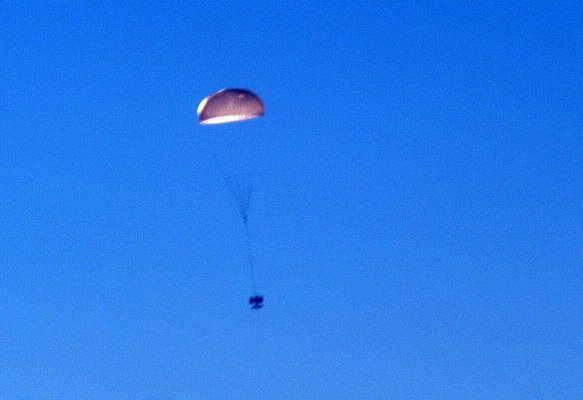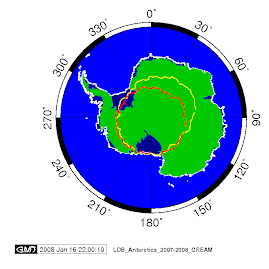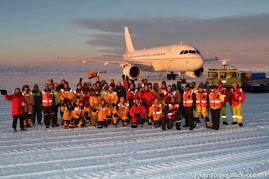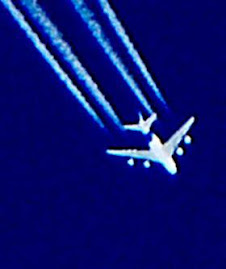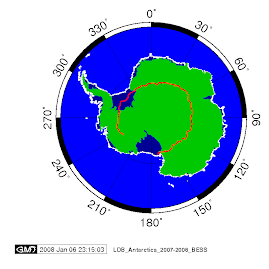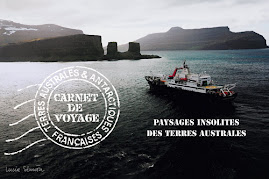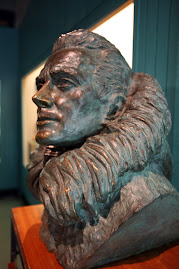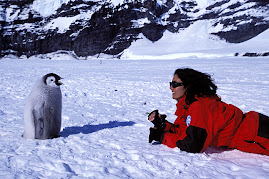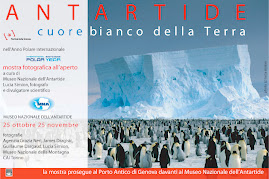
Editorial from THE NEW ZEALAND HERALD, Saturday January 12th, 2008
nzherald.co.nz
Please see photo credits below.
A lifetime of ceaseless achievement
Sir Edmund Hillary's life will always be remembered for the scaling of two monumental heights.
The first was his ascent of Mt Everest, the world's highest mountain, on May 29, 1953. The second was his unblemished subsequent career of service and high endeavour.
If the feat of Sir Edmund and Tenzing Norgay in becoming the first men to stand atop Everest turned heads around the world, his head was not about to be turned by the subsequent adulation.
The humility of his reaction endeared the beekeeper's son to the world.
Over time, Sir Edmund cemented his position as the ultimate figure of a nation's pride precisely because he embodied the values and way of life to which most New Zealanders of his, and any other generation, aspire.
He was craggy in countenance and of raw-boned physique in the best tradition of a backcountry farmer, with a character of constancy, modesty and utter determination to succeed.
Those qualities were immediately apparent after the conquest of Everest, one of the defining acts of the 20th century. "We've knocked the bastard off," he said on returning from the summit.
On the cusp of the technological revolution, "Ed", as he liked to be called, and Tenzing had surmounted one of the great challenges remaining to man. Fifteen previous expeditions had tried and failed.

The achievement placed him in the company of the renowned explorers and adventurers who had gone where no other had gone before - the likes of Columbus, Livingston, Amundsen and Lindbergh.
It was at once recognised as such, and Sir Edmund was feted around the world. Yet, unlike some who went before, he was spoiled by neither this recognition nor the similar acclaim that greeted the success of his subsequent expeditions, including, in 1958, the first overland journey to the South Pole since that of Robert Falcon Scott in 1912.
Indeed, reflecting upon his life, Sir Edmund declared that his most worthwhile achievement had been the building of schools, hospitals, medical clinics and airstrips in Nepal.
It was as though conquering Everest had merely laid the foundation for a life's work on behalf of the local Sherpas.
"That has given me more satisfaction than a footprint on a mountain," he said.
He did not, he said, set out to impose projects. "These are all things that the local people wanted, and we just responded."
Therein lay a lesson that many a heavy-handed development agency could take to heart. Even when the thin air of the Himalayas curtailed his visits there, Sir Edmund remained an inveterate fundraiser for health and education projects in Nepal.

His reward was a mana that led to his being hailed in that region as Burra Sahib, literally "Big Sir", but also translated as "big in heart".
It was a heart that was to suffer grievously when his first wife, Louise, and their 16-year-old daughter, Belinda, were killed when a small plane crashed taking off from a Nepalese airstrip in 1975.
If that was the bleakest time of his life, Sir Edmund soldiered on, finding consolation in his work for the Sherpas.
In 1985, he added another string to his bow when he became High Commissioner to India, a four-year appointment which elevated New Zealand's standing and profile on the subcontinent like no other.
Throughout the tumultuous changes of the latter half of the 20th century and into the 21st century, his standing among New Zealanders never wavered. Young and old, Pakeha and Maori, recognised him as the nation's flagbearer.
When a Herald-DigiPoll survey asked people to nominate the preferred president of a Republic of New Zealand, Sir Edmund was the choice of Maori and young people.
When the Waikato Polytechnic wanted to attract national and international students, it changed its name to the Edmund Hillary Institute of Technology.
If Sir Edmund's response was typically humble, it also showed a trademark pragmatism.
"I'm not all that keen to have my name on too many things," he said. "But I have a liking for polytechnics because they offer practical training, like the sort of things we do in the Himalayas."
On most occasions, Sir Edmund had little say in the way his name and feats were celebrated throughout the country.
A multitude of streets, roads, places, crescents and squares were named in his honour, probably without consultation in many cases.
The name Hillary also became associated with two Auckland schools.
And when in the mid-1980s the Government of the day established a commission for sport, fitness and leisure, there was little debate about which New Zealander best represented its values, aims and ambitions. It became the Hillary Commission.
In his autobiography, View From The Summit, Sir Edmund revealed that he wanted his ashes scattered not on Everest or another scene of mountaineering triumph but on the Auckland's Waitemata Harbour.
Boating on the sparkling waters had been a favourite pastime of Sir Edmund in his youth, and his life had always led him back to Auckland.
He wanted "to be washed gently ashore, maybe on the many pleasant beaches near the place I was born".
Then, he said, the full circle of his life would be complete. What a life it was.
__________________________________________________________________
British adventurer and environmentalist Pen Hadow said Hillary's death "closes one of the great chapters of planetary exploration".
____________________________________________________________________________________
PHOTOS: TOP, The New Zealand flag is lowered at Scott Base, January 11, 2008 (PHOTO by. NANCY COX, The Antarctic Sun). MIDDLE, Sir Ed Hillary at McMurdo Station, Nov. 20, 2004, talks via high-frequency radio with Tracy Sheeley, a communications operator at Amundsen-Scott South Pole Station. Hillary led the first team to reach the South Pole by motorized vehicles -- farm tractors -- in 1958. Photograph by: Brien Barnett/National Science Foundation. LOW, Scott Base Station Manager Mike Mahon, far right, escorts New Zealand Prime Minister Helen Clark and Sir Edmund Hillary from a U.S. Air Force C-17 that landed at Pegasus White Ice Runway on January 18. Clark and Hillary were among the dignitaries attending a ceremony celebrating the 50th anniversary of the founding of New Zealand's Scott Base. Photograph by: Peter Rejcek/National Science Foundation, January 17, 2007.
Please see photo credits below.
A lifetime of ceaseless achievement
Sir Edmund Hillary's life will always be remembered for the scaling of two monumental heights.
The first was his ascent of Mt Everest, the world's highest mountain, on May 29, 1953. The second was his unblemished subsequent career of service and high endeavour.
If the feat of Sir Edmund and Tenzing Norgay in becoming the first men to stand atop Everest turned heads around the world, his head was not about to be turned by the subsequent adulation.
The humility of his reaction endeared the beekeeper's son to the world.
Over time, Sir Edmund cemented his position as the ultimate figure of a nation's pride precisely because he embodied the values and way of life to which most New Zealanders of his, and any other generation, aspire.
He was craggy in countenance and of raw-boned physique in the best tradition of a backcountry farmer, with a character of constancy, modesty and utter determination to succeed.
Those qualities were immediately apparent after the conquest of Everest, one of the defining acts of the 20th century. "We've knocked the bastard off," he said on returning from the summit.
On the cusp of the technological revolution, "Ed", as he liked to be called, and Tenzing had surmounted one of the great challenges remaining to man. Fifteen previous expeditions had tried and failed.
The achievement placed him in the company of the renowned explorers and adventurers who had gone where no other had gone before - the likes of Columbus, Livingston, Amundsen and Lindbergh.
It was at once recognised as such, and Sir Edmund was feted around the world. Yet, unlike some who went before, he was spoiled by neither this recognition nor the similar acclaim that greeted the success of his subsequent expeditions, including, in 1958, the first overland journey to the South Pole since that of Robert Falcon Scott in 1912.
Indeed, reflecting upon his life, Sir Edmund declared that his most worthwhile achievement had been the building of schools, hospitals, medical clinics and airstrips in Nepal.
It was as though conquering Everest had merely laid the foundation for a life's work on behalf of the local Sherpas.
"That has given me more satisfaction than a footprint on a mountain," he said.
He did not, he said, set out to impose projects. "These are all things that the local people wanted, and we just responded."
Therein lay a lesson that many a heavy-handed development agency could take to heart. Even when the thin air of the Himalayas curtailed his visits there, Sir Edmund remained an inveterate fundraiser for health and education projects in Nepal.

His reward was a mana that led to his being hailed in that region as Burra Sahib, literally "Big Sir", but also translated as "big in heart".
It was a heart that was to suffer grievously when his first wife, Louise, and their 16-year-old daughter, Belinda, were killed when a small plane crashed taking off from a Nepalese airstrip in 1975.
If that was the bleakest time of his life, Sir Edmund soldiered on, finding consolation in his work for the Sherpas.
In 1985, he added another string to his bow when he became High Commissioner to India, a four-year appointment which elevated New Zealand's standing and profile on the subcontinent like no other.
Throughout the tumultuous changes of the latter half of the 20th century and into the 21st century, his standing among New Zealanders never wavered. Young and old, Pakeha and Maori, recognised him as the nation's flagbearer.
When a Herald-DigiPoll survey asked people to nominate the preferred president of a Republic of New Zealand, Sir Edmund was the choice of Maori and young people.
When the Waikato Polytechnic wanted to attract national and international students, it changed its name to the Edmund Hillary Institute of Technology.
If Sir Edmund's response was typically humble, it also showed a trademark pragmatism.
"I'm not all that keen to have my name on too many things," he said. "But I have a liking for polytechnics because they offer practical training, like the sort of things we do in the Himalayas."
On most occasions, Sir Edmund had little say in the way his name and feats were celebrated throughout the country.
A multitude of streets, roads, places, crescents and squares were named in his honour, probably without consultation in many cases.
The name Hillary also became associated with two Auckland schools.
And when in the mid-1980s the Government of the day established a commission for sport, fitness and leisure, there was little debate about which New Zealander best represented its values, aims and ambitions. It became the Hillary Commission.
In his autobiography, View From The Summit, Sir Edmund revealed that he wanted his ashes scattered not on Everest or another scene of mountaineering triumph but on the Auckland's Waitemata Harbour.
Boating on the sparkling waters had been a favourite pastime of Sir Edmund in his youth, and his life had always led him back to Auckland.
He wanted "to be washed gently ashore, maybe on the many pleasant beaches near the place I was born".
Then, he said, the full circle of his life would be complete. What a life it was.
__________________________________________________________________
British adventurer and environmentalist Pen Hadow said Hillary's death "closes one of the great chapters of planetary exploration".
____________________________________________________________________________________
PHOTOS: TOP, The New Zealand flag is lowered at Scott Base, January 11, 2008 (PHOTO by. NANCY COX, The Antarctic Sun). MIDDLE, Sir Ed Hillary at McMurdo Station, Nov. 20, 2004, talks via high-frequency radio with Tracy Sheeley, a communications operator at Amundsen-Scott South Pole Station. Hillary led the first team to reach the South Pole by motorized vehicles -- farm tractors -- in 1958. Photograph by: Brien Barnett/National Science Foundation. LOW, Scott Base Station Manager Mike Mahon, far right, escorts New Zealand Prime Minister Helen Clark and Sir Edmund Hillary from a U.S. Air Force C-17 that landed at Pegasus White Ice Runway on January 18. Clark and Hillary were among the dignitaries attending a ceremony celebrating the 50th anniversary of the founding of New Zealand's Scott Base. Photograph by: Peter Rejcek/National Science Foundation, January 17, 2007.
